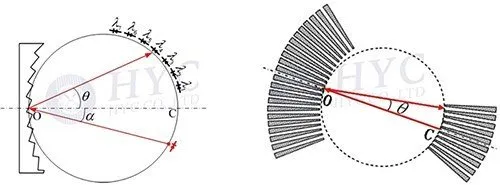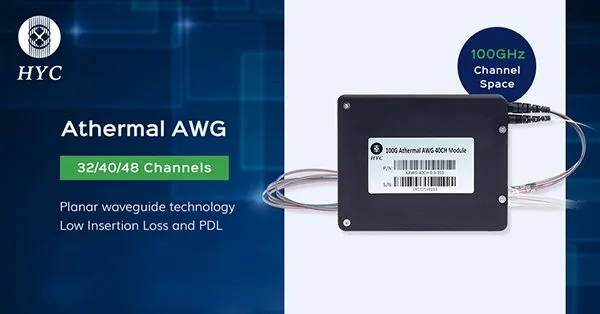AWG is Arrayed Waveguide Grating and is the technology of first choice in dense wavelength division multiplexing systems (DWDM). AWG is a planar waveguide device, which is an arrayed waveguide grating fabricated on a chip substrate using PLC technology. Compared with FBG and TTF, AWG has the advantages of high integration, multiple channels, low insertion loss, and easy batch automated production.
We begin with the principle of a concave grating to better understandard that of the AWG. The structure of a concave grating is shown in Fig.1. The gratings are aligned on a large circle with radius R=2r. There exists a small circle with radius r, which is half of the large circle. The small circle is called Rowland circle. The concave grating provides both functions of a traditional grating and a lens. Light emitting from any point P1 on the Rowland circle will be focused on another point P2 on the circle after diffraction by the concave grating. The diffraction angle θ and incident angle α are related by Eq. (1).

According to Eq. (1), the diffraction angle θ is wavelength dependent. When colorful light emitts from P1, different wavelengths will be focused on different points (near P2) on the Rowland circle.

Fig.1 Diffraction in a concave grating
Now we come to discussion on the AWG. The input/output star couplers have the similar structure as the concave grating. Fig.2 shows the structure of the output star coupler. The endface of the arrayed waveguides are aligned on a large circle with radius R=2r, while the endface of the receiver waveguides are aligned on a small circle (Rowland circle) with radius r. The structure of the input star coupler is similar with the receiver waveguides substituted by one transmitter waveguide at the central position C.

Fig.2 Structure of output star coupler
Let’s see the analogy between the concave grating and the star coupler, as shown in Fig.3. In the concave grating, colorful light emits from one point on the Rowland circle. Different wavelengths are focused on different positions on the Rowland circle. In the star coupler, DWDM signals emit from the central point C of the receiver waveguides, which is on the Rowland circle. If reflective diffraction happens in the arrayed gratings as in the concave grating, different wavelengths will be focused at different positions on the Rowland circle. Then the dispersed wavelengths are received by the receiver waveguides aligned on the Rowland circle. The key point is how can reflective diffraction happen at the arrayed grating.

Fig.3 Analogy between concave grating and star coupler
As the input/output star couplers are the similar, we can fold the AWG as Fig.4. A mirror is placed to symmetrically divide the arrayed waveguides. The left half arrayed waveguides are mirror to the right half. The input star coupler is mirrored to the output star coupler. The transmitter waveguide is mirror to the central position of the receiver waveguides. Thus the operation of the AWG can be regarded as follow. DWDM signals emit from the central position C of the receiver waveguides and are separated into the arrayed waveguides after free propagation in the output star coupler. The multiple beams propagate in the right half of the arrayed waveguides and reflected by the mirror. The reflected multiple beams emit to the output star coupler. After free propagation in the star coupler, different wavelengths are focused on different positions and are received by different receiver waveguides. Thus demultiplexing of DWDM signals is realized.

Fig.4 Folding operation of the AWG
AWG has the advantages of small wavelength interval, large number of channels, and easy integration. It is particularly suitable for ultra-high-speed and large-capacity DWDM systems. It has become the core component of most devices in DWDM systems and is widely used.
HYC launched a 48-channel Athermal Array Waveguide Grating (AAWG), which is mainly used in 400Gbps network applications. Based on the array waveguide grating technology, it does not require additional power supply or temperature control, which is a pure passive module. It has the characteristics of low loss, polarization-dependent loss, low crosstalk, and good stability in the operating temperature range of -40 °C to 85 °C.

Fig.5 DWDM AAWG
About HYC
HYC Co., Ltd was founded in 2000. It is a leading passive optical device OEM / ODM and solution provider, focusing on R&D, manufacturing, sales and service of passive devices. The company's main products are: optical fiber connectivity products, WDM wavelength division multiplexers, PLC optical splitters, and MEMS optical switches, which is widely used in 4G / 5G networks, Telecom, Data centers, etc.